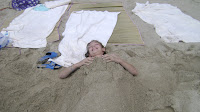Hey, everyone! Well, it's about time that I updated this old blog! So here goes. :) Since our Aussie Thanksgiving, we have gone on a really huge trip in Australia. We took a combined trip to both the Great Barrier Reef and the Australian Outback. Our first stop was at the Great Barrier Reef. We stayed on Hamilton Island for four days, enjoying for the first couple of days relaxation and access to a nice pool.
We also got a buggy in which to drive around the island.
And yes, I am an excellent driver. :) This island was amazing. Exotic birds like peacocks and cockatoos would just come right up and eat off your breakfast plate!
This peacock was right outside our hotel door! And so was this lizard... :[
It is probably about as long as my arm! Just a little scary to find coming home from doing your Christmas shopping... So, anyway, on our third day in Hamilton Island, we went to the Barrier Reef! We took a boat out to a section of the reef.
It was very windy up on the top deck. :) And so here we had our first looks at the Great Barrier Reef from above the water:
The light blue-turquoise color in the water is the Reef. :D
We put on our snorkelling gear and away we went!
This was, as you may imagine, the biggest fish that we saw all day! It is called a groper fish, and the people at the reef named him George the Groper. :) Mom and I got to touch him and watch them feed him small scraps left over from lunch! To give you an idea of his size, he is about three and a half feet long, which is more than half the size of me!
After we left the Great Barrier Reef, we headed out into the Outback. We were going to see Uluru (formerly known by Ayers Rock). I don't suppose that most of you know about Uluru (pronounced OO-loo-roo), so I will briefly fill you in. It is this giant rock, one single rock, a monolith in the center of Australia. It is about six miles around and about 1000 feet high. It now belongs to the native Anangu people as a sacred worship site. Another really strange and interesting fact about Uluru is that from the air, it is shaped just like a giant human heart, which is amazingly coincidental because of its location in the very center of the continent and it is also essential to the preservation of life in that part of the Outback. When rain does fall in that desert, it collects on top of Uluru, and Uluru's many waterfalls distribute water evenly throughout the land, and the people are able to collect it and live on it. So it is obviously quite a strange and magnificent landmark.
This was our first view of it from our tour bus. The rock is still quite far away from us, maybe half a mile. So you can see how really huge it is.
This is a very close up view. It is dry now, but if you look, you can see thick black marks and lines. These are dried up waterfalls. When they dry, they leave a black bacteria behind. Also, you can see that the waterfalls dont just run down the rock in straight lines. They come down slowly and settle in the holes on the sides of the rock. Then when those holes fill up, the water falls out of those into the next hole and so on, making a pattern that makes the waterfall look somewhat like a snake coming down the mountain, in and out.
We had an Anangu tour guide and an Australian interpreter on our tour of Uluru. In one of Uluru's several caves, our Anangu guide showed us the writings of her ancestors.
Another monolith just a few miles away from Uluru is Kata Tjuta (KA-ta JU-ta). This one is much, much larger than Uluru, several times in length and several meters higher. It is not as well known because it is not as sacred to the Anangu people as Uluru, but still amazingly fascinating. So we spent a few hours there.
It was an amazing trip. We'll keep you posted more frequently on our goings on if we can. Til the next post, see ya!






















































